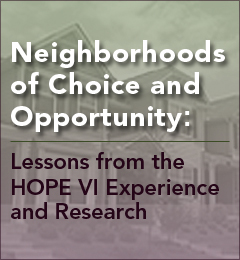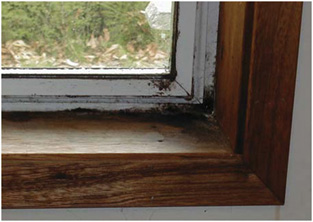|

The conference showcased research using 2009 American Housing Survey data to address current housing issues
The American Housing Survey (AHS) is conducted by the U.S. Census Bureau to provide housing data for HUD. It is the most detailed, regular national housing sample survey in the country designed to obtain data on apartments, single-family homes, mobile homes, vacant homes, family composition, income, housing and neighborhood quality, housing costs, equipment, fuels, sizes of housing units, and recent movers. The national survey has had the same core fixed sample of about 50,000 homes since 1985, which provides a panel data series on homes and household changes over the years. Newly constructed units are also added each time, so that approximately 60,000 housing units across the country are surveyed every two years. Surveys are also conducted for selected metropolitan areas approximately every six years. As a result, AHS data are available for tracking and analyzing national or particular metropolitan housing trends.
Last summer, HUD’s Office of Policy Development & Research (PD&R) issued a call for research papers that would apply the special features of the 2009 national AHS data sets to housing issues of current interest. The invitation sought a broad range of proposals that would build on existing work, explore new approaches or issues, and recommend ways to improve the survey. The papers submitted were highlighted at the first AHS Users Conference, held at HUD headquarters in Washington, DC on March 8, 2011. The conference presenters’ research, which will be featured in the next issue of ResearchWorks, represents a wide spectrum of perspectives and housing interests from researchers, academics, private and public sectors, graduate students, and consultants. Broad topics that were covered include research on housing for special needs populations; assisted housing; innovative AHS data uses; housing wealth, rental affordability, and disaster recovery.
Dr. John Weicher, Director of Hudson Institute’s Center for Housing and Financial Markets, delivered the keynote address, placing today’s AHS in historical context. Weicher is as an economist who has often used the AHS in research and is currently using the AHS data to compare the affordable rental housing stock between 1985 and 2009. Weicher is well known at HUD for his service as Assistant Secretary for Housing and Federal Housing Commissioner (2001–05), Assistant Secretary for PD&R (1989–93), Chief Economist (1975–77), and division director in the Office of Economic Affairs (1973–1974). Weicher has been a member of the Census Advisory Committee on Population Statistics, chair of the Committee to Evaluate the Research Plan of HUD’s National Research Council, and is a current Advisory Board member of Cityscape.
Coverage of research from the conference will be in future issues of ResearchWorks. Click here for selected presentation content.
BACK TO THE TOP
HUD’s 2009 biennial assessment of “worst case housing needs” explores the number of unassisted very low-income renter households (earning incomes of 50% or less of the area median income (AMI) who pay more than half their monthly income for housing (97.2%), live in severely substandard housing (2.9%), or both (3.4%).1 The thirteenth in the series, this recent study finds that households with worst case needs (WCNs) increased by nearly 1.2 million — more than 20 percent between 2007 and 2009 — to over 7 million. The table below shows an increasing proportion of U.S. households experiencing worst case needs since 2001. Although the total number of households increased by 6 percent between 2001 and 2009, the incidence of WCNs is 42 percent higher than in 2001.

This acceleration is attributed to several factors, including the recession. An estimated 35 percent of the expansion of WCNs is attributable to an increase in very low-income renters caused by rising unemployment and shrinking incomes. Another 19 percent of the increase is attributable to a lack of rental assistance for needy renters. The largest portion of the increase (41%) can be traced to competition for affordable rental units that leads to displacement, absorption of vacancies, and higher rents. To illustrate, during 2007–2009, the mean gross rent for very low-income renters rose by more than 10 percent, while the number of vacant, affordable units fell by 370,000.
The predominance of severe rent burden caused by WCNs highlights the role of household incomes in exacerbating the problem. Of the approximately 7.1 million WCN households in 2009, two-thirds have extremely low incomes, earning 0–30 percent of the AMI.
WCNs are found in every region, metropolitan, suburban, and rural area in the country, and no racial or ethnic group is untouched by the rise in WCNs (see graph). The most common type of WCNs household is families with children under 18 (38.5%); the number of these families grew by 550,000 from the 2007 level, outpacing the increase of very low-income households in this category. The next most common household type experiencing this hardship, at 33.8 percent of all cases, was “other nonfamily” households that include individuals and unrelated people sharing a home. Elderly households without children (18.7%) and “other families” without children or with adult children (8.9%) also experienced significant increases in WCNs.

Almost 990,000 (13.9%) of the WCNs households in 2009 included one or more nonelderly individuals with disabilities, compared with 8.3 percent of all U.S. households and 11 percent of all renters.
To learn what the study found in terms of the shortage of affordable housing and for details that can aid in understanding the trends in worst case needs, see Worst Case Housing Needs 2009: Report to Congress.
1Using one-half or more of income to pay for housing is defined as a severe rent burden.
BACK TO THE TOP


Since 1992, HOPE VI has employed a strategy of improving both individual lives and communities through creation of mixed-income communities. While studies have shown that the impacts of HOPE VI individual projects have been somewhat mixed, overall outcomes indicate that it has been effective in eradicating concentrations of poverty, improving residents’ quality of life, and driving neighborhood renewal. Building on the experience of HOPE VI, HUD has introduced the Choice Neighborhoods initiative to reach beyond individual public housing redevelopment and achieve neighborhood transformation.
Sponsored by HUD’s Office of Policy Development and Research and the Council of Large Public Housing Authorities, the Neighborhoods of Choice and Opportunity forum was held on March 16, 2011, and examined the impact of HOPE VI on residents, developments, and neighborhoods from both the researcher and practitioner perspectives. More than 250 participants attended the half-day event, which explored some of the ways that HOPE VI and Choice Neighborhoods can promote community revitalization. To view select forum presentations and related content, go to Hope VI Conference page

BACK TO THE TOP
Designers of durable homes work at a disadvantage in the absence of sound, measurable data on indoor humidity levels in buildings. Relative humidity affects thermal and respiratory comfort, occupant perceptions of indoor air quality, and influences the amount of energy needed for heating and air conditioning. If relative humidity is high, biological contaminants, such as dust mites and mold, can flourish. If it remains high over a prolonged period, physical damage to the home is possible.

Mold on the inside of a window can negatively affect respiratory health and cause structural damage.
To provide better tools for reducing the uncertainties and hazards occasioned by excessive moisture, HUD created a data set that engineers and building scientists can use to analyze relationships between indoor temperature and humidity. In this effort, HUD collaborated with members of the Committee for the Criteria for Moisture-Control Design Analysis in Buildings of the American Society of Heating, Refrigeration and Air-Conditioning Engineers (ASHRAE), an industry leader in setting standards for the proper design of heating, ventilating, and air conditioning equipment. The Oak Ridge National Laboratory assisted in designing the research methodology used in the study.
Researchers collected a full year of indoor temperature and humidity data in a sample of 60 homes located across three different climate regions — the Southeast where it is hot and humid; the Northeast, a cold climate; and the Northwest, known for its marine environment. Multiple locations in each home were sampled every 15 minutes, producing over nine million individual temperature and humidity readings. Monitoring involved three site visits to each home to record basic house and equipment characteristics, install data loggers, perform testing to quantify envelope leakage and duct leakage, and collect data recorded by the loggers.
Some of these data regarding characteristics of the sample homes and of the moisture problems documented are shown in Tables 1 and 2 below. Unique findings emerged for housing in each region:
-
The homes in the Northwest region were the oldest, with air leakage rates twice as high as elsewhere. The dominant foundation type here is the vented crawlspace with a dirt floor. The mild, marine climate requires less space conditioning and dehumidifying, so fewer homes are air-conditioned. Across the three regions, the Northwest homes had the highest interior relative humidity.
-
Residences in the cold Northeast had the largest incidence of water leakage and the highest level of moisture problems. Most homes here are built on partially finished, conditioned basements. Musty odors were observed within conditioned spaces and sometimes on upper floors of a home.
-
The hot and humid Southeast, where homes are predominantly built on slabs, had the newest homes, and all had central air conditioning. As was the case in all three regions, the highest incidence of moisture damage was on or around windows and bathrooms. In the Southeast, mold was also observed around the cooling coil of several air handlers, usually located in unconditioned space, such as a garage.
Conclusion
The data collected in this study will aid researchers and engineers in developing construction standards and best practice guidelines that will reduce the likelihood of moisture-related problems in new homes. The research team concluded that major differences in houses from the three regions are generally attributable to age, air leakage, foundation type, cooling equipment, and heating equipment.
The small sample size excluded strong correlations between housing characteristics and indoor humidity levels. After evaluating the data by and across regions, and after comparing the homes that did and did not have moisture problems, the research team identified variables needing further investigation in terms of their relationship with increased humidity levels: high air-change rates, high-occupant densities, unfinished and unconditioned basements and crawlspaces, and use of materials with higher condensation and mold potential, such as metal windows and marble window sills in the hot and humid Southeast.
Table 1. Average House Characteristics by Region

Source: U.S. Department of Housing and Urban Development, Office of Policy Development and Research, Monitoring of Internal
Moisture Loads in Residential Buildings, Washington DC, 2010, p. 17.
Table 2. Summary of Moisture Problems in Study Homes.

Monitoring of Internal Moisture Loads in Residential Buildings, p. 33.
BACK TO THE TOP


- Evidence Matters, a new quarterly newsletter published four times a year, debuted with the Winter 2011 issue, which has recently been released. View the inaugural issue and sign up for a free print or electronic subscription here.
- The Office of Policy Development and Research has just launched the HUD USER eBookstore, which offers a selection of our most popular housing research in eBook-friendly formats. As always, downloads are free! Visit our eBookstore here.
- HUD’s Office of Policy Development and Research held a conference on March 8 on early results from the newly released American Housing Survey data sets. Selected presentations from the conference can be viewed here; an article on this event appears elsewhere in this issue.
- HUD’s Office of Policy Development and Research and the Council of Large Public Housing Authorities cosponsored a half-day forum on March 16 titled “Neighborhoods of Choice and Opportunity: Lessons from the HOPE VI Experience and Research.” Click here for more information and to view selected presentations from this event; the next issue of ResearchWorks will include a feature article on the forum.

BACK TO THE TOP
|



